Keeping more than one tarantula is a debate topic among owners. Most tarantulas cannot be kept together with males being exceptionally territorial. They live solitary lives in the wild for a reason.
That being said, something you should know is that some species can be kept together, but there is no guarantee that you will be successful.
When deciding to keep more than one tarantula in a single habitat, it will take a lot of monitoring to ensure that the one is not attacking the other or doesn’t eat the other.
Continue reading to find out more.
Table of Contents
List of Communal Tarantulas
Some of the tarantula’s owners have had success at keeping communally, including:
1. Socotra Island Blue Baboon
Scientific name: Monocentropus balfouri.
Common name: Socotra Island Blue Baboon.
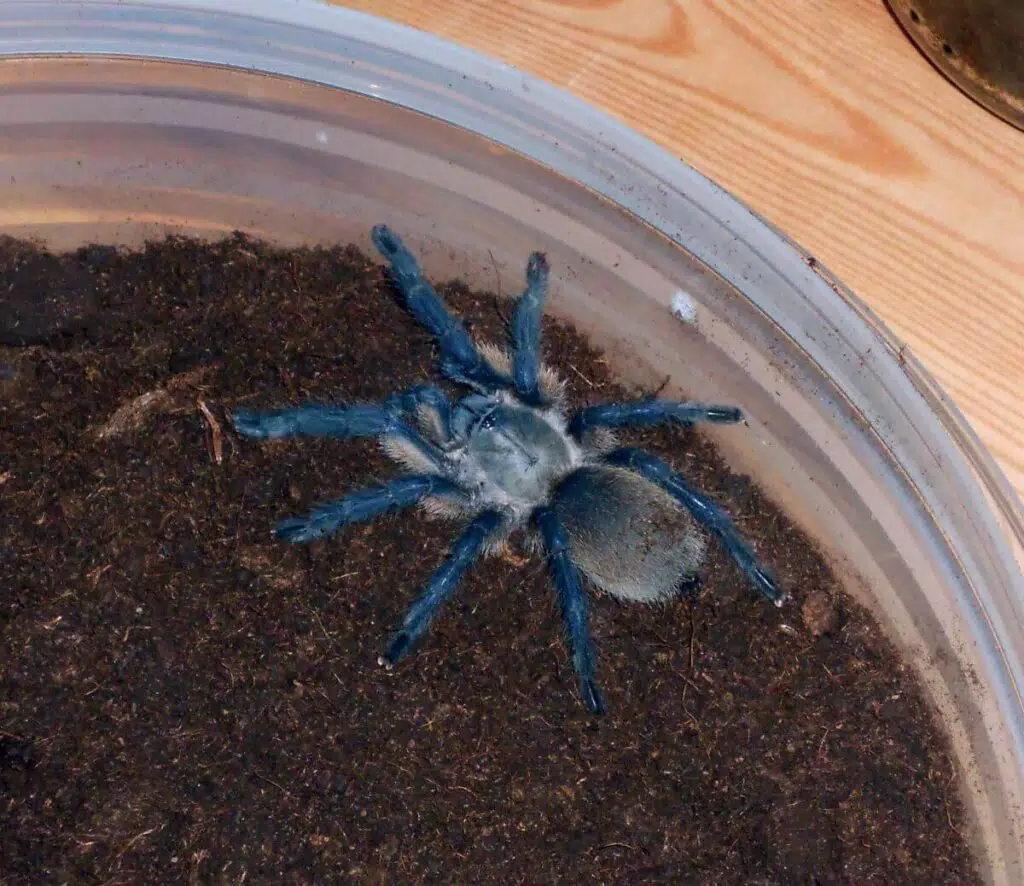
The monocentropus balfouri can grow to 12cm and is an Old World tarantula with a calm temperament.
They are both aggressive and defensive if provoked with females living for up to fifteen years and males up to four years. They prefer burrowing into the substrate with webbing at the enclosure.
They can be kept communally with a lot of success. They can also be kept with other monocentropus balfouri that are from a different egg sac.
When choosing to keep different specimens together, not from the same egg sac, it’s a good idea to create a new enclosure and add everyone at the same time.
It is not advisable to put a mature female and mature male together for the first time if they have not been raised in a communal setup.
2. Orange Baboon Tarantula
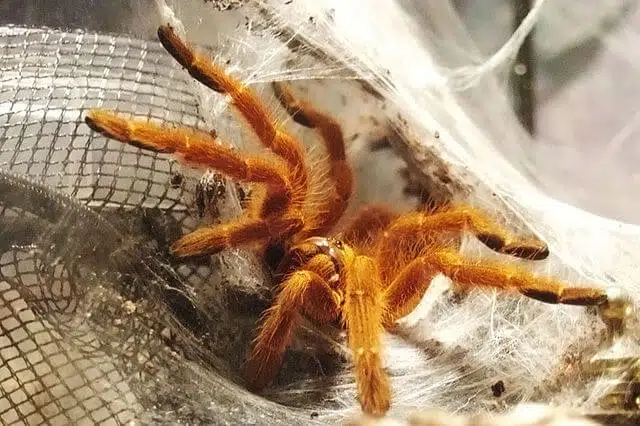
Scientific name: Pterinochilus murinus.
Common name: orange baboon tarantula, Mombasa golden starburst tarantula.
The female pterinochilus murinus can grow to six inches (15cm) with males growing to 10cm. Their carapace has a star-shaped pattern with a fishbone pattern on the abdomen. They have short hair covering their bodies. They are orange in color and very defensive and will bite if provoked.
It is not recommended to keep this species unless you have experience with exotic and venomous spiders.
They are burrowing spiders and are known to tolerate a communal environment if done so from spiderlings.
3. Gabon Blue Dwarf Baboon
Scientific name: Heterothele gabonensis.
Common name: Gabon Blue Dwarf Baboon.
The Heterothele gabonensis is a dwarf tarantula from Africa that is believed to be communal with many owners having success keeping more than one spider in a communal setup.
They grow to two inches and are fast-growing. They need a terrestrial setup and are semi-arboreal. They are not aggressive, are very fast, and tend to be skittish in nature.
4. red slate ornamental
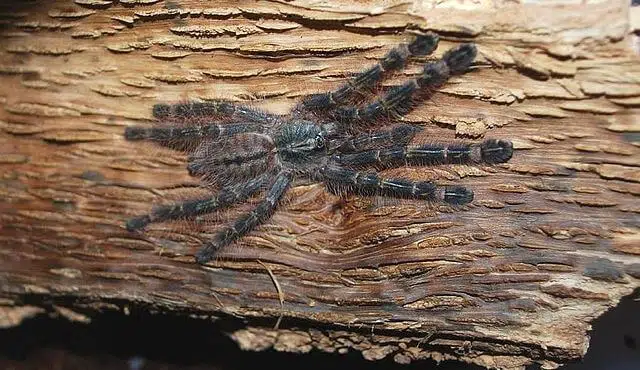
Scientific name: Poecilotheria rufilata.
Common name: red slate ornamental, reddish parachute spider, Travancore slate-red, rufus parachute spider.
Poecilotheria rufilata is an arboreal tarantula, endemic to India, and is endangered due to habitat loss and pet trade smuggling. Females are larger than males, growing to around 8cm in body length.
The first and fourth pair of legs are yellow with the femur being yellow ending in black with a thin yellow band.
They live in tree hollows and in rock crevices and are known to live in human areas.
They are flighty and skittish and will bite without thinking twice. The spiderlings are also exceptionally fast and grow quickly and strong.
They are not beginner spiders and in captivity, you will want to provide them with a habitat that matches what they would choose in the wild with a tall cage.
5. Pederson’s ornamental
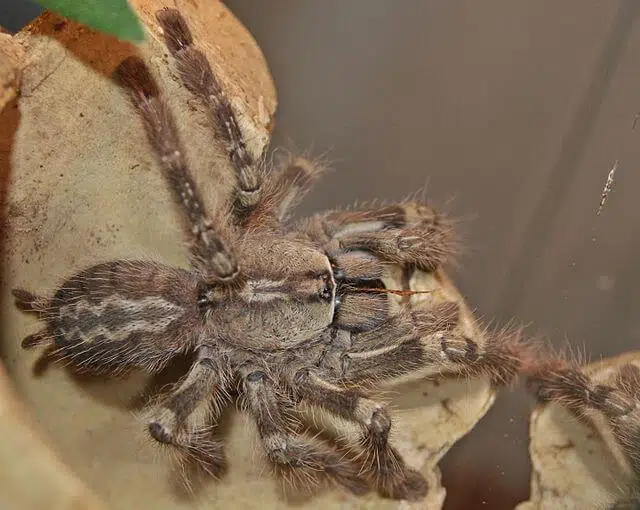
Scientific name: Poecilotheria vittata.
Common name: Pederson’s ornamental, the ghost ornamental, magam tiger spider.
The Poecilotheria vittata is a tiger tarantula with brushes on the femurs and a triangular stripe o the femur on the fourth pair of legs.
Females grow to 7cm and males to around 5cm.
They live under tree bark, in tree hollows, rock crevices, and in human habitats. They are docile but will bite if provoked.
Success in keeping this species in a communal enclosure has only been achieved when they have been in contact with each other since they were spiderlings, enabling them to establish their territory inside the tank.
6. Coremiocnemis tropix
The coremicocnemis tropix is a pygmy tarantula that is semi-social with some success keeping them in communal enclosures.
They live in rainforests, burrowing and sheltering under rocks and logs. Females can grow to 3cm with a 6.5cm leg span.
They are one of the few species that extend their maternal care with many tolerating their offspring for a period of time, sometimes more than a year. They allow their young to stay at home and let them feed on their captured prey.
Siblings share living quarters and prey, making them easier to introduce into a communal setup.
7. Bengal ornamental
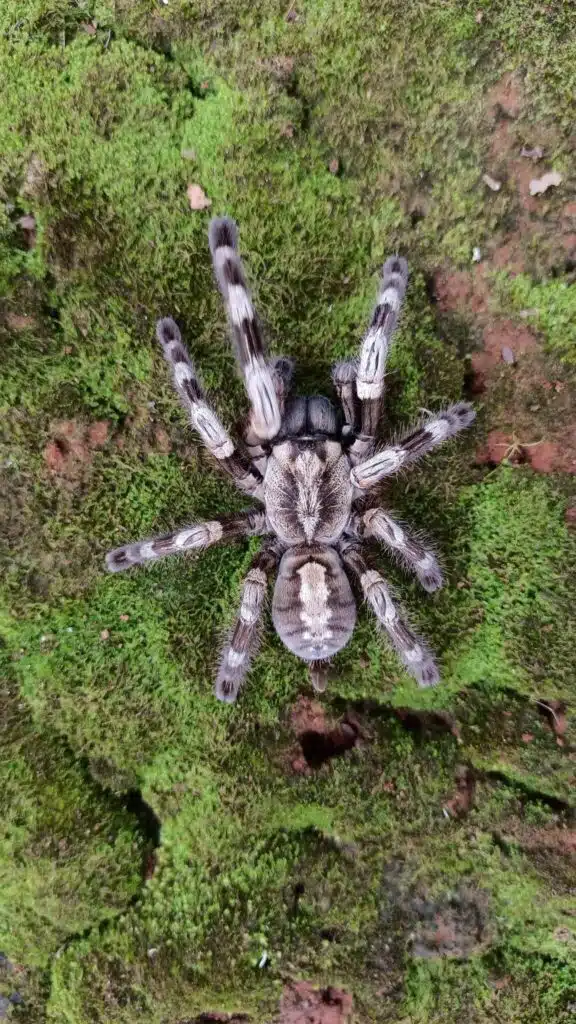
Scientific name: Poecilotheria miranda.
Common name: Bengal ornamental.
Poecilotheria miranda or the Bengal ornamental tarantula is endemic to India. The first and fourth pair of leg are marked the same, where the femur is black with a white band. The patella is white/cream and the tibia is white with a black band.
These tarantulas are fast from spiderling to adults and they grow large. They have potent venom, though they are not that aggressive. They will give a bite if provoked.
There has been a success at keeping this tarantula in a community set up with more success when introducing them to the community as spiderlings, all of the same size.
8. Ivory ornamental
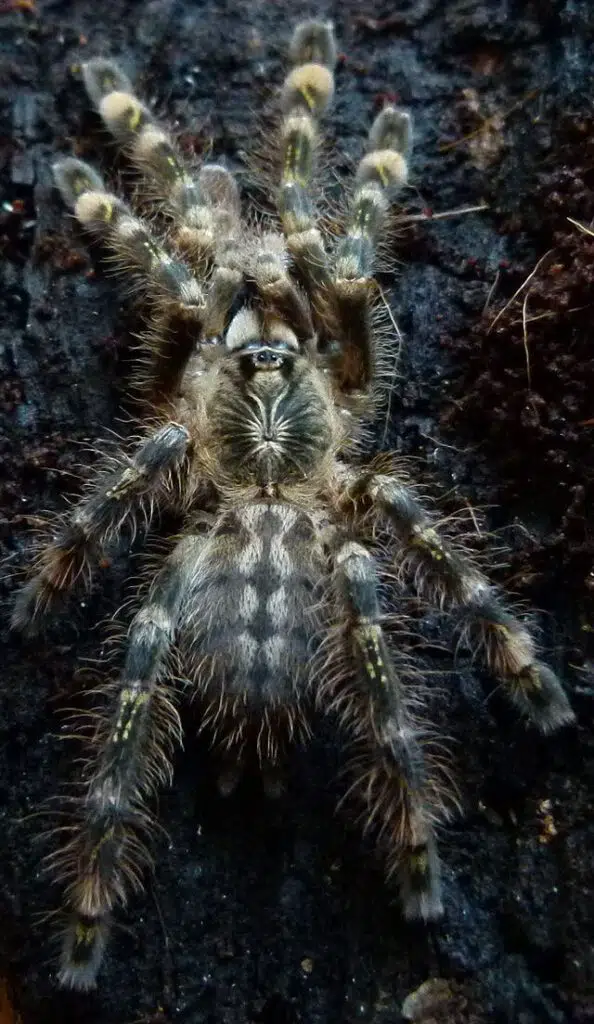
Scientific name: Poecilotheria subfusca.
Common name: ivory ornamental.
Poecilootheria subfusca is known as the ivory ornamental tarantula, endemic to Sri Lanka.
Females are larger than males growing to 9cm in body length. Females are dark brown with pale edges and a starburst pattern. They have cream-colored chelicerae and all four legs are identical. Their femur is black/brown with a cream band.
The males are pale brown with inconspicuous markings. Their legs are metallic brown.
They are very agile and skittish and will bite if provoked. They often have a mutualistic relationship with frogs, sharing tree holes.
9. Trinidad olive tarantula
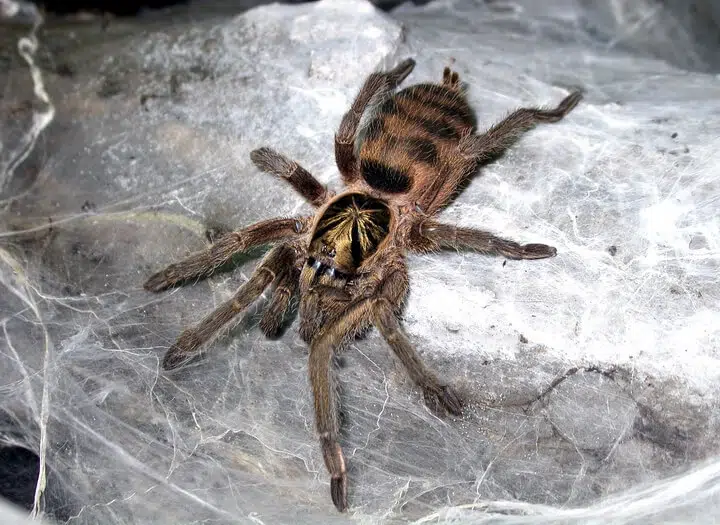
Scientific name: Neoholothele incei.
Common name: Trinidad olive tarantula.
The Neoholothele incei is another of the tarantulas where owners have had some success with communal setups.
These tarantulas come from Venezuela and Trinidad, often referred to as the Trinidad olive tarantula. Their leg span can exceed 7.5cm when they are mature.
They are popular pets and very easy to breed.
They are known to live communally with cannibalism being rare. They will only eat another tarantula if they are starved.
10. Salem ornamental
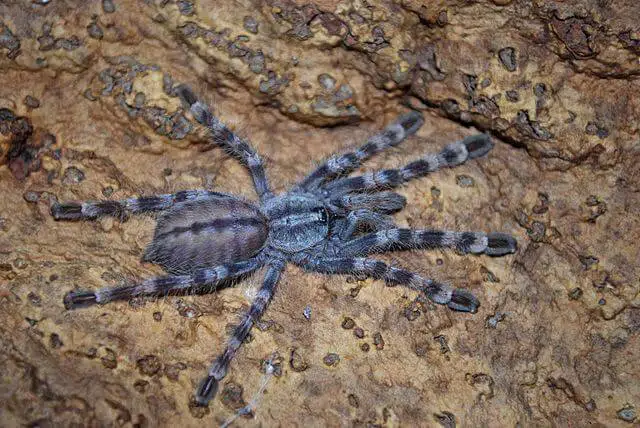
Scientific name: Poecilotheria formosa.
Common name: salem ornamental, beautiful parachute spider, finely formed parachute spider.
Poecilotheria formosa is known as the Salem ornamental or beautiful parachute spider.
These large tarantulas can grow to 20cm and are an Old World Arboreal tarantula with a fast growth rate that is not suitable for beginner tarantula owners, as they can be defensive and aggressive.
They are exceptionally fast from spiderling to adults with purple showing through the mostly black and white coloration with yellow on the underside of the legs.
They grow large with huge fangs and toxic venom, which is considered medically significant if you are bitten.
They are not that aggressive or defensive, which is why there has been some success in keeping this species in a communal setup.
11. Indian ornamental tree spider
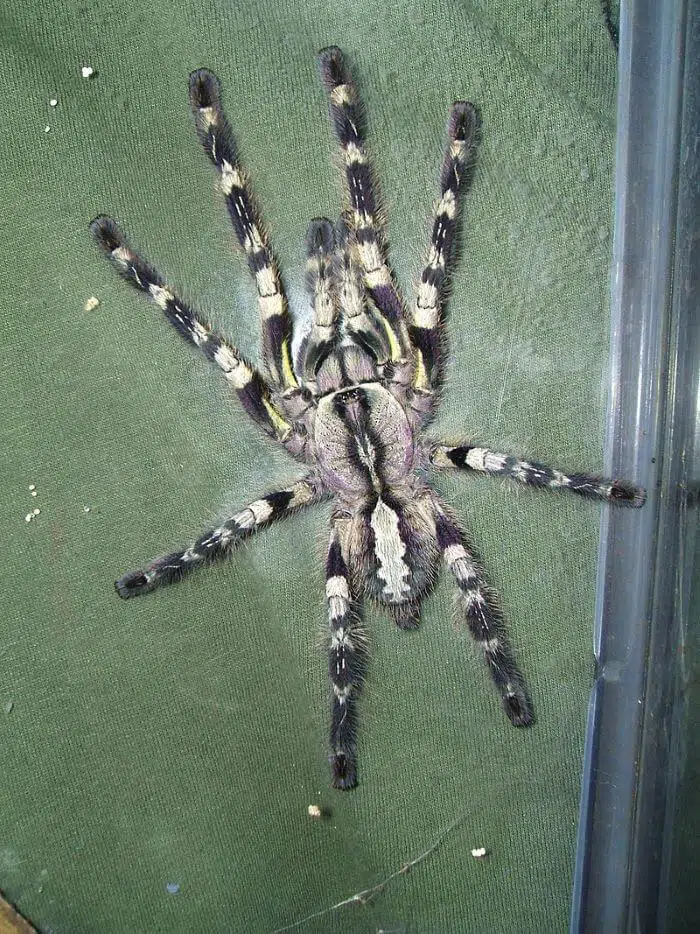
Scientific name: Poecilotheria regalis.
Common name: Indian ornamental tree spider, Indian ornamental.
Poecilotheria regalis is an arboreal tarantula from India, also known as the Indian ornamental tree spider, and is common for amateur collectors growing to a leg span of 18cm. They live in the holes of tall trees and prey on flying insects.
These are some of the few tarantulas known to willingly live in a community when there is limited space in the tree, even though they are defensive.
They are very popular as pets, despite their fast speeds and potent venom. Females can live up to twelve years in captivity.
12. Tanzanian Chestnut
Scientific name: Heterothele villosella.
Common name: Tanzanian Chestnut, Tanzanian Chestnut Baboon Spider.
The Heterothele villosella or Tanzanian olive tarantula is a dwarf species growing to 6cm.
They are Old World burrowing tarantulas with communal tendencies and a fast growth rate.
They are docile but tend to be very nervous and skittish. These docile and easy-to-care-for tarantulas are ideal for beginners.
They have a beautiful chestnut pattern on the abdomen with a starburst pattern on the carapace.
It will bite if provoked but tend to be slow to anger.
This is one of the true communal tarantulas, which means you can keep it in a communal setup with Tanzanian chestnut baboon tarantulas as well as its own species.
13. Rameshwaram ornamental
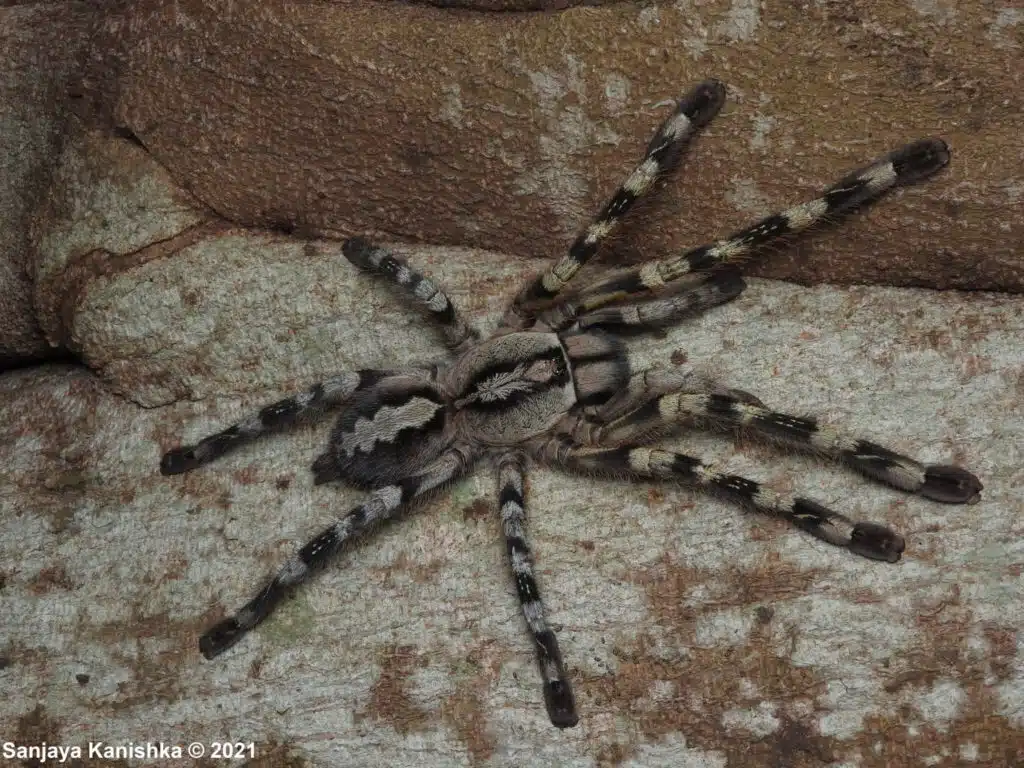
Scientific name: Poecilotheria hanumavilasumica.
Common name: Rameshwaram ornamental, Rameshwaram parachute spider.
Poecilotheria hanumavilasumica, also known as the Rameshwaram ornamental is an endangered tarantula with daffodil yellow on the front pair of leg. The fourth pair of legs is blue-gray with a black patch.
They grow to 18cm and are arboreal Old World tarantulas that have a medium to fast growth rate and are not suitable for beginners. They are fast from sling to adult and grow quality.
They have potent venom and while it is not aggressive they will give a defensive bite, which could result in hospitalization.
Experienced owners have had some success having more than one of this species in an enclosure.
14. yellow-backed ornamental
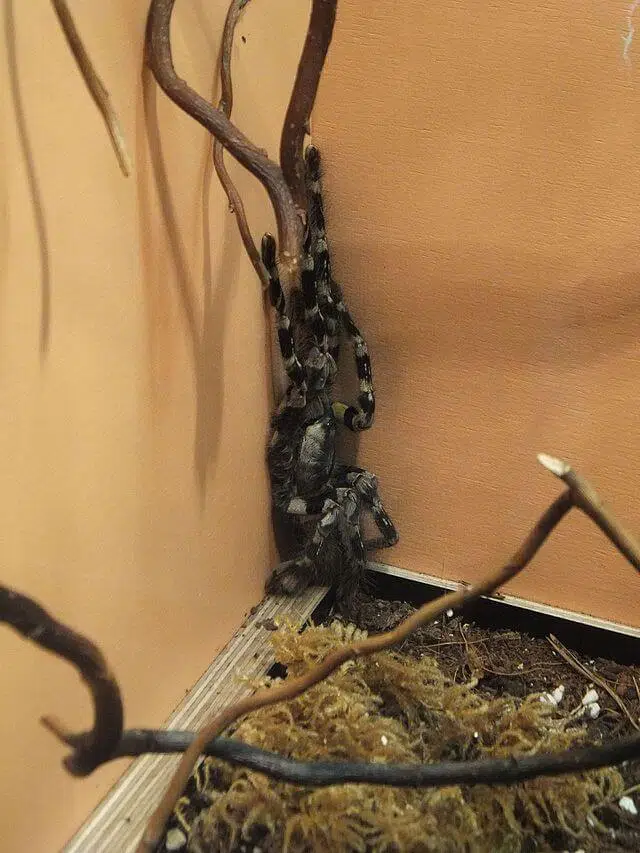
Scientific name: Poecilotheria smithi.
Common name: yellow-backed ornamental.
Poecilotheria smithi is a yellow-backed ornamental tarantula and is a large arboreal species endemic to Sri Lanka and considered endangered.
Females are larger than males, growing to 7cm. Females have a dark brown carapace with a brown to black tibia and a v-shaped light patch on the tarsus.
The males are a green to brown color with folio markings that are darker in color.
There has been success putting this species in a communal tank as long as the temperature, humidity, feeding, and case are perfect. Missing one of these important habitat needs can result in one killing the other.
15. Hysterocrates gigas
Scientific name: Hysterocrates gigas.
Common name: giant baboon spider, Cameroon red baboon spider, red baboon tarantula.
Hysterocrtes gigas is a Cameroon red baboon spider, a burrowing spider that can range from gray to a dull black or a rusty brown/orange color. They have an oval-shaped abdomen that can be up to 10cm in diameter with hairy legs. The leg span can reach 20cm. The male’s abdomen is smaller than the female’s.
They attend to burrow in the soil and are common in subtropical and tropical environments.
16. Wessel’s tiger ornamental
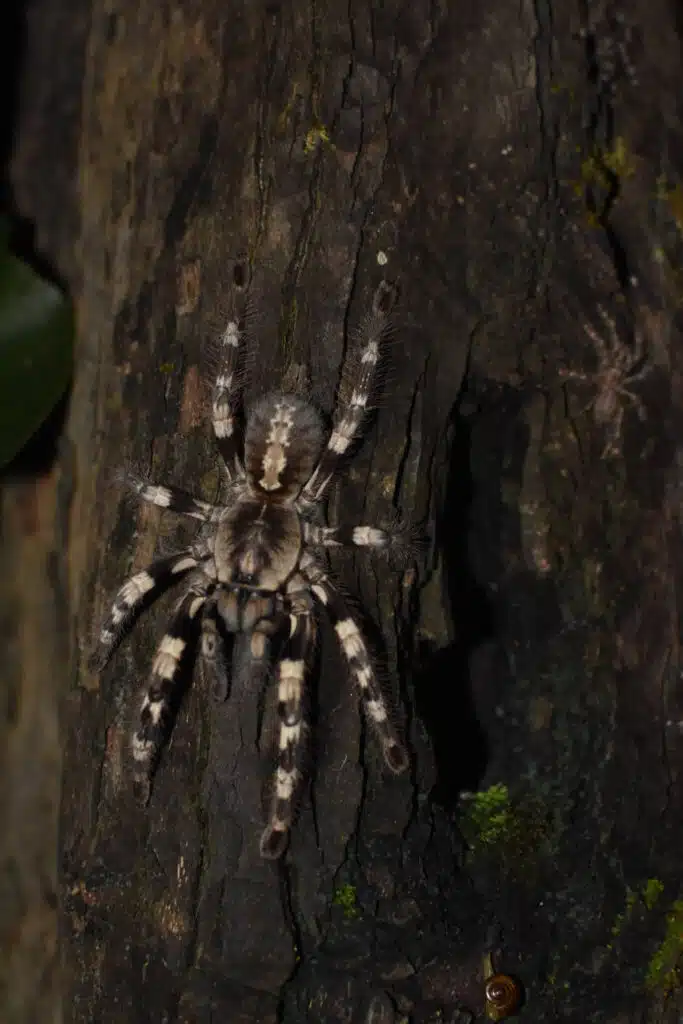
Scientific name: Poecilotheria tigrinawesseli.
Common name: Wessel’s tiger ornamental, Anantagiri’s parachute spider.
A poecilotheria tigrinawesseli can grow to 18cm and is an arboreal Old World tarantula with a fast growth rate that is not recommended for beginners.
They can be aggressive and defensive and inflict a very painful bite if provoked.
There has been some success in communal living for these tarantulas when introduce as spiderlings.
What Species To Start With
When it comes to a communal tarantula setup, you need to consider two important factors:
- Success rate
- Cost
Success Rate
Keeping a communal tarantula tank can work out expensive so you want the best success rate possible, which is why Monocentropus balfouri is a highly recommended choice with many owners having success with this species in a communal environment.
They are suitable for those that are new to tarantulas. Even though they can be fast-moving, they are less defensive and more affordable.
For the best success rate, you should start with spiderlings, rather than adults.
It’s also recommended that you buy spiderlings from the same egg sac even though there is no real evidence to tell you otherwise, it can help improve your success rate.
Cost
The cost comes down to each person and how much you want to spend. You can purchase a few of the Monocentropus balfouri tarantulas or you can try with a more affordable species.
Communal Tarantula Setup
Setting up a communal tarantula tank takes time and care. There are a few important factors to take into consideration, these include:
Do Not Use a Big Tank
The secret to keeping communal tarantulas is to have a smaller enclosure, so they are always in contact with each other.
If you give them too much space, they will naturally become territorial, which can result in cannibalism. If they are kept too close together and are fed regularly, the risk of cannibalism is greatly reduced.
If you find one removes itself from the group, it’s recommended to remove that spider and rehouse it elsewhere.
How Many Tarantulas Should You Start With?
If you want to keep tarantulas in a community setup, you should consider breeding them. Seven is a great number to start with, so you are ensured of having more than one male and female.
You can start with two spiderlings, but they could be the same sex which means that there will be no mating.
How to Feed a Tarantula Community
A tarantula spiderling should be fed an appropriately sized cricket twice a week and this should be done in the communal enclosure, ensuring your spiderlings receive the right amount of food.
They will eat each other if they are hungry. You need to ensure that you add enough prey that the whole colony can eat.
Maintaining a Communal Tarantula Set Up
The good news is that you should not have to remove your spiders during maintenance with good housekeeping. Use a tweezer to remove old molt and dead uneaten prey regularly. You can place a stone in the water dish, which reduces the risk of prey drowning.
The sides of the cage will need to be cleaned regularly with arboreal species. Misting the sides, allowing the poop to soften, enable you to remove it using a wet towel and tweezers.
Molting
A tarantula is at its most vulnerable when it’s about to molt or has just molted. It has been noted in communal species that the group allows mates to molt among them without attacking or killing them during the molting process.
It is still important to observe your spiders regularly if one is molting to ensure it is not picked on or killed. You should not need to separate your tarantulas during this time.
Summary
A successful communal setup is when you have spiderlings growing to maturity, mating, laying eggs, incubating, mothering, and establishing a territory, accommodating the new additions.
You can say you have a successful tarantula community when you have three generations of the same species living in one enclosure.
Further Reading: